-
Car Reviews
- All reviews
- Midsize SUVs
- Small cars
- Utes
- Small SUVs
- Large SUVs
- Large cars
- Sports SUVs
- Sports cars
- Vans
Latest reviews
- Car News
-
Car Comparisons
Latest comparisons
- Chasing Deals
The i30 Sedan N brings more space – and pace – to Hyundai’s feted N performance range, and under the skin, it’s a different animal to the hatch it shares a badge with
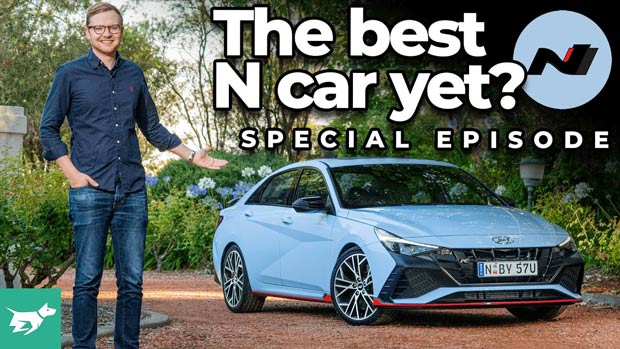
In wrapping up an ambitious plan to release 18 new models in 18 months, Hyundai in many ways saved the best to last.
The quickest member of the now five-strong N Performance lineup is now here: perhaps counterintuitively, the most frenetic N car (in a straight line, at least) takes the traditionally conservative shape of a sedan.
“Conservative” isn’t really a term you’d use for the creased, edgy styling of the CN7-generation i30 Sedan that launched in late 2020 in base two-litre and turbo 1.6-litre N Line versions.
Those mainstream variants arguably carry the super-bold lines of this three-box car with a hint of awkwardness that evaporates in full-fat N trim, identifiable by crisp 19-inch snowflake alloy wheels, extensive red lower trim, and available Performance Blue paint.
But while the i30 Sedan N runs the benchmark 0-100km/h sprint in 5.3sec in eight-speed dual-clutch automatic form – or 5.5sec with the six-speed manual gearbox that Hyundai Australia partially funded the tooling for – this vehicle’s talents extend far beyond simply planting the boot and aiming for the horizon.
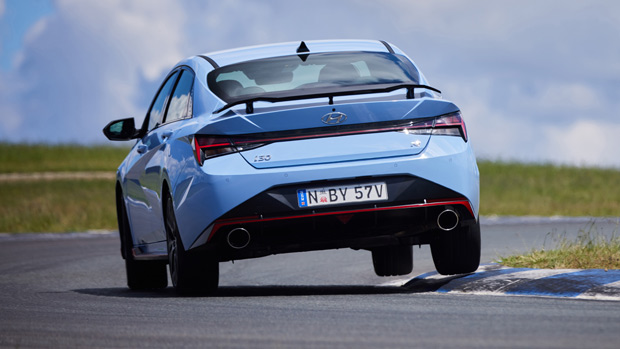
Running an entirely platform under the skin to the hatchback, and sitting on a 70mm-longer wheelbase, the CN7 i30 Sedan N shares some attributes with its well-resolved facelifted i30 N hatchback sibling but brings a different slate of attributes to the table.
Better-balanced for the kind of grand touring driving that characterises many Australian road trips, the i30 Sedan N is more laid-back than the hatch in both the country and the ‘burbs – but find a tight, winding, technical piece of road and it turns on similar charms to the five-door with which it shares an engine, gearbox, exhaust and LSD.
While much of the mechanical package of the i30 Sedan N is shared with the five-door i30 N hatchback and the soon-to-be-discontinued i30 Fastback N – plus the new Kona N sports SUV – the significant platform differences make the sedan a noticeably different animal in many driving situations.
First, what’s kept: a 2.0-litre turbocharged petrol four-cylinder engine that makes the same 206kW of power and 392Nm of torque – in a meaty, flat band between 2100-4700rpm – plus a choice of six-speed manual gearbox or an eight-speed wet-clutch DCT automatic.
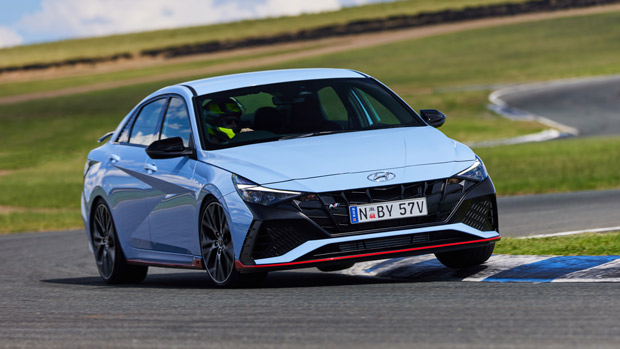
Like all other N products that have come to Australia, the sedan also scores an electronically-locking, mechanically-controlled front limited slip differential that allows it to claw its way out of corners on the throttle – especially long, uphill ones that would see vehicles with an open differential scrabbling for much traction.
Being equipped with an LSD and very grippy Michelin Pilot Sport 4S tyres – a first for an N-car – puts the i30 Sedan N into a higher plane of effectiveness than its larger brother, the $50,990 Sonata N-Line, which has stronger outputs (213kW/422Nm) from its 2.5-litre turbo engine but runs with an open diff.
The LSD in the sedan doesn’t feel as aggressive as it is in the hatchback, where its effectiveness is absolutely dramatic, but it still allows you to put power down much earlier in corner exit than a front-wheel drive platform normally allows.
You still can’t be totally lazy and simply point-and-shoot with the throttle like you can in an all-wheel drive Audi S3 sedan ($72,400), but nor would you want to: the i30 Sedan N’s best virtue on road and track is how beautifully balanced this FWD vehicle is.
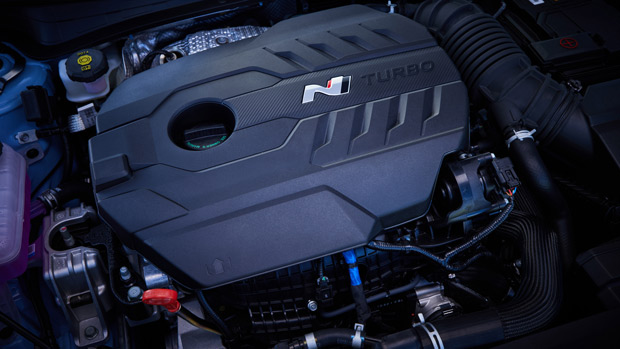
While the LSD is something of a get-out-of-gaol-free card, it still pays dividends to set the i30 Sedan N up well on corner entry, deftly lifting the throttle and perhaps dabbing the brake to lighten the rear end, which dutifully slips around behind the car in the deft and locally-calibrated ESC Sport setting.
The eight-cm longer wheelbase of the sedan means there is more car to keep in check underneath you, but there is plenty of fizz and feel shuttled through the chassis to your bottom and hands – this is a communicative car. It’s not too heavy, either; the manual weighs 1468kg, the DCT 1503kg – 40kg lighter than their hatch counterparts.
That said, the electric power steering, while feelsome, is overly heavily-weighted even in its lightest setting, dubbed normal. It’s liveable, but hot hatches and their sedan counterpart don’t need to feel like muscle cars through the wheel.
That wheel includes a red push-to-pass button (lablled NGS for N Grin Shift) if you opt for the crisp eight-speed wet DCT that gives 20sec of 213kW of overboost and max response from the transmission, which is at all times impressive: shifts are knocked off quickly and smoothly.
Shift logic is sufficiently clever in the transmission’s Sport and Sport Plus modes that it can be left in the D-gate but control can be taken manually by the plastic shifters behind the perforated leather steering wheel.
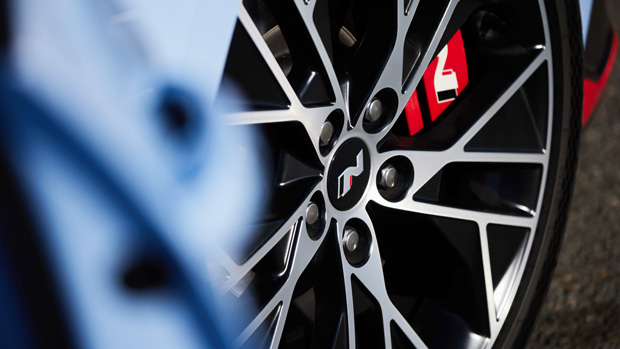
Frankly, the DCT auto suits this car, but Hyundai Australia poured considerable effort into bringing the option of a six-speed manual, shared with the hatch. Second gear is too short but apart from this, the manual is quite a joy to use: it’s not as snicketty as the Honda Civic Type R’s shift but it’s a feel-good thing, rowing your own gears.
Capable of 0-100km/h sprints in 5.3sec (DCT) and 5.5sec (manual), the i30 Sedan N enters respectably quick territory and it feels usable and flexible on the road, with a roar of 392Nm of torque available in a nice, flat plane. Lag is minimal and while the engine doesn’t sound the cleanest at high RPMs it is effective.
Hyundai have been able to retain the 2.0-litre’s signature N exhaust setup here, which crackles and pops very freely in the manual and easily enough in the DCT auto, as well. Those who prefer this effect off can do so via the custom N pages in the 10.25-inch touchscreen.
The 360mm front brake discs are up for the challenge on the road, never feeling overwhelmed on our spirited and traffic-free run up and down Sydney’s Putty Road, but on a big and fast track like Eastern Creek, the pedal goes pretty long by lap five or six.
A pad upgrade, and even stickier tyres, would be immediate changes you could make if you wanted to track this car regularly, which you should – because it’s a great deal of fun, involving and fast. This inexperienced track tester was able to put down 1:54s at Motorsport Park without huge effort.
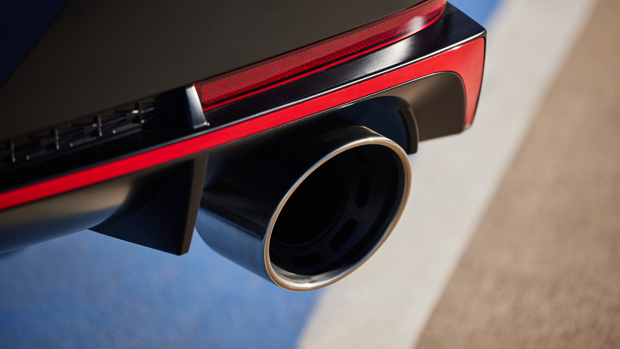
When you’re not out to drive for fun the i30 Sedan N feels a bit quieter than its infamously noisy hatchback cousin. It settles down quite well; the ride is busy but still compliant and well-damped, with the Australian engineers completing a bespoke tune for the Normal (comfort) and Sport modes.
On the safety front, the notable omission is adaptive cruise control; it’s manual. Forwards AEB is standard, though, as is blind spot monitoring (by sensor and not by camera, unlike some other newer Hyundai cars), lane keeping assistance, parking sensors and a reversing camera.
When the hatchback version of the i30 N first launched we remarked that the money had been spent where it mattered – underneath the car, and not in the cabin. Grey and fairly spartan save for a few pops of Performance Blue trim and switchgear, the hatch didn’t eclipse the chic tartan-clad Volkswagen Golf GTI for interior charm, nor the metallic precision of a Civic Type R for tactility.
Scratch deeper in the hatch, though, and you find that the interior actually is very high quality in places – it gets soft door trims front and back, for instance. This is missing on the sedan, which in certain high-up interior areas feels like it’s pushing it at an asking price of $49,000 before on-road costs.
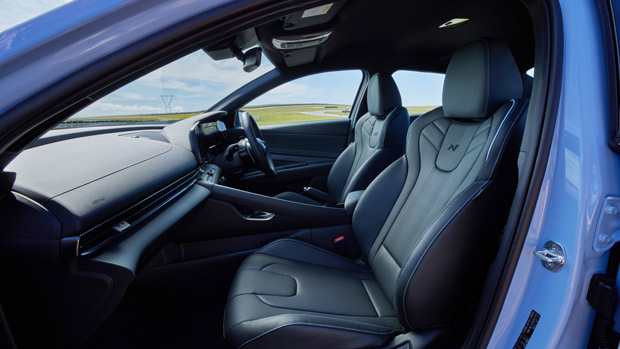
Sure, soft materials probably aren’t what you are here to read about; we get that, but that Hyundai was able to give the hatch a higher air of opulence than the more GT-focussed sedan is unusual and a little unfortunate.
Thankfully, the major touchpoints – the small-diameter, perforated leather steering wheel, the leather gear shifters and the very impressive seats – are all deserving of high marks.
Those seats feature 10-way power adjustment for the driver and are only really missing up/down lumbar adjustment to be perfect; their shape and form kept us more than comfortable for several hours in the saddle. Their standard heating and cooling makes them suitable for Australian driving all-year-round.
There is just one i30 Sedan N specification in Australia – the $49K Premium – which includes leather, electric seats, a Bose stereo and sunroof all as standard. It’s worth noting the hatchback can be had for $4500 less if you can make do without these luxuries … and a cheat code is that the ‘base’ cloth hatch seats are actually even better-formed again.
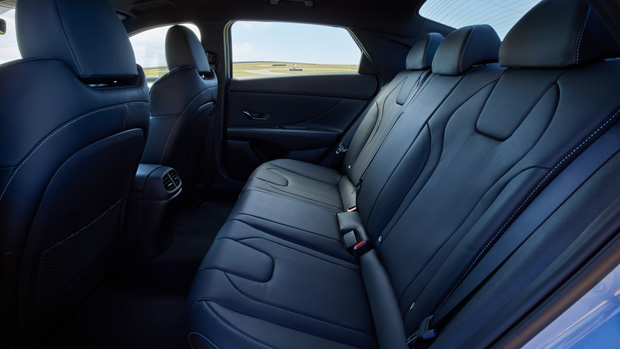
Largely unchanged from the original i30 N hatch is the steering wheel, though it now incorporates a motorsport-style circular red button for push-to-pass on the DCT or a shortcut to turn automatic rev-matching on or off in the manual.
However, there is now Audi RS-style quick access to two custom-configurable N modes via large Performance Blue pads beneath the main spokes of the steering wheel; the prior function of these pads was to cycle through all seven driving modes of the i30 N. This can now be done next to the shifter, while the steering wheel shortcuts make jumping to your own preferred setups much easier.
For us, this meant assigning mode 1 to settings perfect for most Australian B-roads: more compliant suspension and lighter steering, combined with max-attack for the engine, LSD and exhaust, plus mid-point settings for the ESC and transmission map.
Mode 2 could then be assigned for track use or glossy-smooth roads, with very firm suspension, heavier steering, and even ESC completely off with a second tap for confirmation.
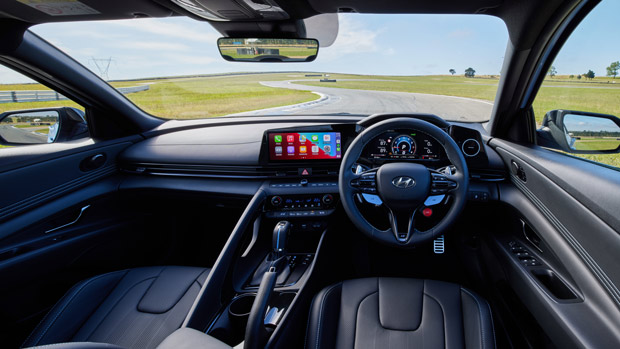
Behind and next to the steering wheel are twin 10.25-inch screens. The centre one has touch capability and runs Hyundai’s latest infotainment system, which is fairly easy to use (if a retrograde step compared to the super-simple software of the original i30 N). Navigation and digital radio are standard but Apple CarPlay and Android Auto require a cable…
We enjoyed the eight-speaker Bose stereo, which is on the modest side in speaker count for a premium unit but has plenty of power and decent clarity, too.
The driver gets a crisp and well-featured digital instrument pack that now includes a rather Audi RS-style (again!) central tachometer providing temperature and boost readouts in its orbit. Regular twin dials are also selectable and put key information at a glance with specific designs for the different drive modes.
Storage up front is reasonable, with decently large door bins, a small-ish central box, usable cupholders, and wireless smartphone charging ahead of the shifter.
Where family buyers will prefer the i30 Sedan N as a second car over the hatch is in the second row, which is enormous for a so-called small car – in reality, this 4675mm-long sedan on a 2720mm wheelbase is midsize, like a Skoda Octavia RS ($53,990 driveaway) or the fondly-remembered Honda Accord Euro.
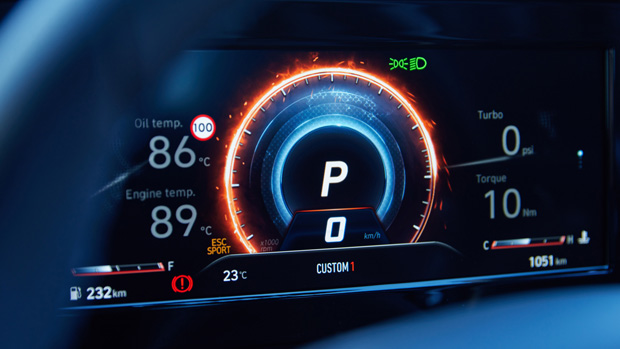
Legroom is very generous, even for six-footers, while headroom offers just enough space despite the standard sunroof. Getting someone into the centre seat could be done if you had to, but the setup is most comfortable for four.
Like the hatchback, boot space in the i30 Sedan N is restricted by the fitment of a lateral brace that increases the rigidity of the vehicle. This severely limits the flat-folding capability of the cargo space, but if you don’t need this, outright room is OK: at 464 litres, the four-door is up by 83L or 21 percent on the hatch. Beneath the boot floor is a space-saver spare.
The i30 Sedan N is pretty inexpensive to run, though the fuel consumption is only average and servicing is required every 10,000km, which is more frequent than many rivals that allow 15,000km between scheduled maintenance.
You can pre-purchase a service plan for the i30 Sedan N to lock in today’s prices. Three are available: three years/30,000km costs $1005, four years/40,000km sets you back $1340, and five years/50,000km is priced at $1675.
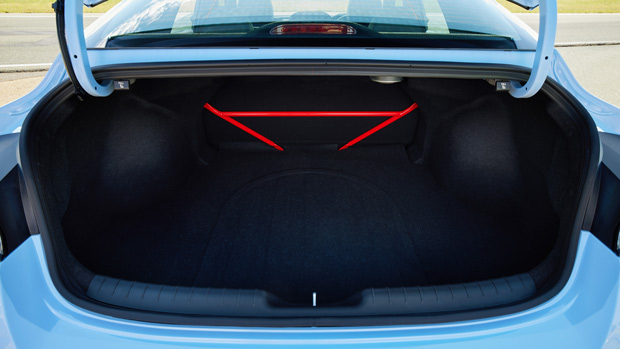
Requiring 95-octane premium petrol, the i30 Sedan N consumed a reasonable 8L/100km on our spirited country-road run before escalating to 10L/100km to 12L/100km with suburban running thrown in.
Hyundai go above-and-beyond when it comes to the warranty on their N cars. Non-competitive, non-timed track use does not void the warranty on the vehicle, which lasts for five years with unlimited kilometres.
Good value, well-equipped and enjoyable to drive sums up the Hyundai i30 Sedan N. This is one of the best-resolved N products from Hyundai yet, combining higher levels of GT-car refinement for longer trips with the same, familiar agility for technical roads and track sessions that can be covered under warranty.
While purists will prefer the rawness, aggression and stripped-back profile of the cloth-seated i30 N hatch base model, the availability of a well-appointed sedan (with optoinal manual!) gives the Hyundai N lineup even more bandwidth.
Throw in the Kona N small SUV and spirited i20 N baby-hot hatch and this is a remarkably complete lineup. What’s missing? Something with AWD, something with more cylinders, and something electric… but watch this space.
Variant tested N PREMIUM
Key specs (as tested)
About Chasing cars
Chasing Cars reviews are 100% independent.
Because we are powered by Budget Direct Insurance, we don’t receive advertising or sales revenue from car manufacturers.
We’re truly independent – giving you Australia’s best car reviews.
The estimate provided does not take into account your personal circumstances but is intended to give a general indication of the cost of insurance, in order to obtain a complete quote, please visit www.budgetdirect.com.au. Estimate includes 15%^ online discount.
^Conditions Apply
Budget Direct Insurance arranged by Auto & General Services Pty Ltd ACN 003 617 909(AGS) AFSL 241 411, for and on behalf of the insurer, Auto & General Insurance Company Limited(ABN 42 111 586 353, AFSL 285 571).Because we don’t know your financial needs, we can’t advise you if this insurance will suit you. You should consider your needs and the Product Disclosure Statement before making a decision to buy insurance. Terms and conditions apply.
Indicative quote based on assumptions including postcode , 40 year old male with no offences, licence suspensions or claims in the last 5 years, a NCD Rating 1 and no younger drivers listed. White car, driven up to 10,000kms a year, unfinanced, with no modifications, factory options and/or non-standard accessories, private use only and garaged at night.
^Online Discounts Terms & Conditions
1. Discounts apply to the premium paid for a new Budget Direct Gold Comprehensive Car Insurance, Third Party Property Only or Third Party Property, Fire & Theft Insurance policy initiated online on or after 29 March 2017. Discounts do not apply to optional Roadside Assistance.
2. Discounts do not apply to any renewal offer of insurance.
3. Discounts only apply to the insurance portion of the premium. Discounts are applied before government charges, taxes, levies and fees, including instalment processing fees (as applicable). The full extent of discounts may therefore be impacted.
4. We reserve the right to change the offer without notice.